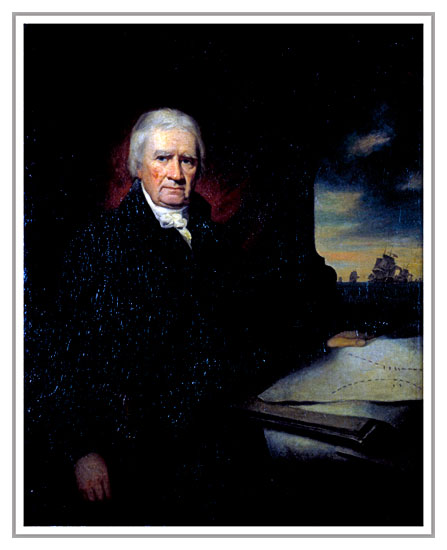|
Important early connections in his life were his friendship
with the architect Robert Adam (he married Robert’s youngest
sister Susannah) and through him, with the English artist Paul
Sandby. The Clerks had become closely connected with the Adam
family, who owned and operated one of the most important
building businesses in Scotland. William Adam, Robert’s
father, had improved the Clerk home of Penicuik House and he
was subsequently commissioned to build Mavisbank House for
them. William Adam also held the key contract from the
government for the expansion of Fort St George, a military
fort on the Moray Firth. It was in their time at Fort St
George that the Adams were introduced to Paul Sandby who was
working there as part of the Board of Ordnance, the body
responsible for military infrastructure and mapping. It was
therefore through the Adams that John Clerk met Paul Sandby.
Indeed, Robert Adam, Sandby and Clerk are known to have taken
drawing trips together.
Drawing was something that Clerk learned at any early age. His
father regarded it as an essential skill, mainly for military
use (though Clerk never joined the military). Clerk turned out
to have natural talent for drawing and, with assistance from
Sandby, came to be better than most. Their subjects focused on
historic buildings and are topographical in nature. Clerk’s
style of the handling is, as it is in Robert Adams’ early
work, influenced by Sandby as well as European masters whose
prints and drawings were highly collected.
With Sandby and Robert Adam’s support, Clerk was persuaded to
take up etching. Although Clerk would have known Sandby's own
etchings, Clerk himself does not mention any teachers and so
we must consider him as self taught. His early career was
seemingly haphazard, a trial and error education. Overall,
Clerk of Eldin went on to produce over one hundred and ten
etchings, from the first impressions from around 1770 to the
last in 1778. It is difficult to say exactly when he started
etching; he states himself to have commenced at age forty
five, that is in 1773, but as dated works of 1772 survive,
this is unlikely. The standard even in 1772 is too high for a
complete beginner.
Clerk made sets of etchings to sell, though this was at a time
well before any concept of formal editions. He printed up to
order. Many sets were sold via Thomas Philipe, a print seller
with a shop opposite the Tron Church in Edinburgh who was
eventually given the task of doing the actual printing from
Clerk’s plates, Clerk often struggling to get good enough
impressions himself. His images, handled in a style that owed
much to European master printers, from Claude Lorraine to
Franz Edmund Weirotter, capture the castles and ruins of
Scotland in a fine picturesque manner. They are of a
surprisingly high quality for an amateur printmaker.
Clerk was well known and well respected in the Edinburgh area,
and like many gentlemen from the Age of Enlightenment, was
involved in a wide variety of activities and business
interests. He wrote a book on naval tactics that arguably
changed the way in which the Admiralty fought their sea
battles. And through his friendship with James Hutton, a
fellow student and friend from University days, he provided
the illustrations for Hutton’s influential book ‘Theory of the
Earth’.
In 1763 Clerk bought an estate near Lasswade, adjoining the
Pendreich coalfields which he had come to manage in the
previous year for the firm Scott and Clerk, in which he later
had a half share. On this estate "he built his little mansion
of Eldin, laid out its beautiful terrace and its singular
garden, and converted an old cottage into a greenhouse, which
was more ornamented with his beautiful clay models than with
plants." (Rt. Hon. William Adam) The name 'Eldin' derives from
an old Scots word ‘elding' or 'eilding' meaning fuel - Clerk
named the house 'Eldin’ in accord with his coal mining
business. By 1793, Clerk had retired from the coal trade, but
still moved between Eldin and Edinburgh, having bought a house
on Princes Street in 1788, overlooking the castle “.... where
it is most precipitous and .... in appearance equable to
anything that can be seen the Highlands .... “(Clerk of
Eldin). He was a popular member of Edinburgh society being
“….looked up to by all the philosophers of his day, who
received hints and views from him which they deemed of great
value.” (Lord Cockburn)
On Clerk of Eldin’s death in 1812, the collection of prints
and plates were retained by his family, and in 1825, with the
help of his son, John Clerk, then Lord Eldin, the Bannatyne
Club of Edinburgh issued a volume of etching called 'Etchings,
Chiefly Views of Scotland by John Clerk of Eldin'. This
publication contained twenty-six views. In 1855, the Bannatyne
Club published another issue, this time with seventy-six
etchings, as additional plates had been discovered at Eldin.
It is understood that The Bannatyne Club then destroyed the
plates, their quality having seriously deteriorated.
|
